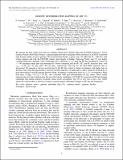Files in this item
Robotic reverberation mapping of arp 151
Item metadata
| dc.contributor.author | Valenti, S. | |
| dc.contributor.author | Sand, D. J. | |
| dc.contributor.author | Barth, A. J. | |
| dc.contributor.author | Horne, K. | |
| dc.contributor.author | Treu, T. | |
| dc.contributor.author | Raganit, L. | |
| dc.contributor.author | Boroson, T. | |
| dc.contributor.author | Crawford, S. | |
| dc.contributor.author | Pancoast, A. | |
| dc.contributor.author | Pei, L. | |
| dc.contributor.author | Romero-Colmenero, E. | |
| dc.contributor.author | Villforth, C. | |
| dc.contributor.author | Winkler, H. | |
| dc.date.accessioned | 2016-06-07T14:30:04Z | |
| dc.date.available | 2016-06-07T14:30:04Z | |
| dc.date.issued | 2015-11-05 | |
| dc.identifier | 243132733 | |
| dc.identifier | 835909e4-7bb0-4da0-9a11-091f95784eb0 | |
| dc.identifier | 000365035000014 | |
| dc.identifier | 84947060036 | |
| dc.identifier | 000365035000014 | |
| dc.identifier.citation | Valenti , S , Sand , D J , Barth , A J , Horne , K , Treu , T , Raganit , L , Boroson , T , Crawford , S , Pancoast , A , Pei , L , Romero-Colmenero , E , Villforth , C & Winkler , H 2015 , ' Robotic reverberation mapping of arp 151 ' , Astrophysical Journal Letters , vol. 813 , no. 2 , 36 . https://doi.org/10.1088/2041-8205/813/2/L36 | en |
| dc.identifier.issn | 2041-8205 | |
| dc.identifier.uri | https://hdl.handle.net/10023/8945 | |
| dc.description | Research by A.J.B. and L.P. are supported by NSF grant AST-1412693. Research by D.J.S. is supported by NSF grant AST-1412504 and AST-1517649. Research by T.T. is supported by NSF grant AST-1412315 and a Packard Research Fellowship. E.R.C. and S.C. gratefully acknowledge the receipt of research grants from the National Research Foundation (NRF) of South Africa. | en |
| dc.description.abstract | We present the first results from the Las Cumbres Observatory Global Telescope (LCOGT) Network's Active Galactic Nuclei (AGNs) Key Project, a large program devoted to using the robotic resources of LCOGT to perform time domain studies of active galaxies. We monitored the Seyfert 1 galaxy Arp. 151 (Mrk. 40) for similar to 200 days with robotic imagers and with the FLOYDS robotic spectrograph at Faulkes Telescope North. Arp. 151 was highly variable during this campaign, with V-band light curve variations of similar to 0.3 mag and H beta flux changing by a factor of similar to 3. We measure robust time lags between the V-band continuum and the H alpha, H beta, and H gamma emission lines, with tau(cen) = 13.89(-1.41)(+1.39),7.52(-1.06)(+1.43), and 7.40(-1.32)(+1.50) days, respectively. The lag for the He II lambda 4686 emission line is unresolved. We measure a velocity-resolved lag for the H beta line, which is clearly asymmetric with higher lags on the blue wing of the line that decline to the red, possibly indicative of radial inflow, and is similar in morphology to past observations of the H beta transfer function shape. Assuming a virialization factor of f = 5.5, we estimate a black hole mass of M-BH = 6.2(-1.2)(+1.4) x 10(6)M(circle dot), also consistent with past measurements for this object. These results represent the first step to demonstrate the powerful robotic capabilities of LCOGT for long-term AGN time domain campaigns that human intensive programs cannot easily accomplish. Arp 151 is now one of just a few AGNs where the virial product is known to remain constant against substantial changes in H beta lag and luminosity. | |
| dc.format.extent | 5 | |
| dc.format.extent | 667555 | |
| dc.language.iso | eng | |
| dc.relation.ispartof | Astrophysical Journal Letters | en |
| dc.subject | Galaxies: active | en |
| dc.subject | Galaxies: individual (Arp 151) | en |
| dc.subject | Galaxies: nuclei | en |
| dc.subject | Galaxies: Seyfert | en |
| dc.subject | Techniques: spectroscopic | en |
| dc.subject | QB Astronomy | en |
| dc.subject | QC Physics | en |
| dc.subject | NDAS | en |
| dc.subject.lcc | QB | en |
| dc.subject.lcc | QC | en |
| dc.title | Robotic reverberation mapping of arp 151 | en |
| dc.type | Journal article | en |
| dc.contributor.sponsor | Science & Technology Facilities Council | en |
| dc.contributor.institution | University of St Andrews. School of Physics and Astronomy | en |
| dc.identifier.doi | 10.1088/2041-8205/813/2/L36 | |
| dc.description.status | Peer reviewed | en |
| dc.identifier.grantnumber | ST/M001296/1 | en |
This item appears in the following Collection(s)
Items in the St Andrews Research Repository are protected by copyright, with all rights reserved, unless otherwise indicated.

